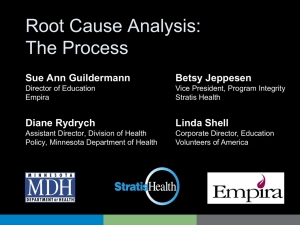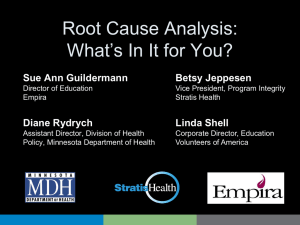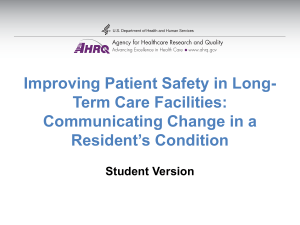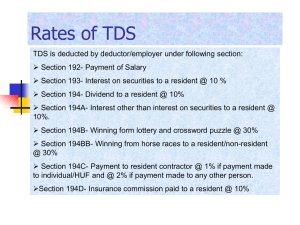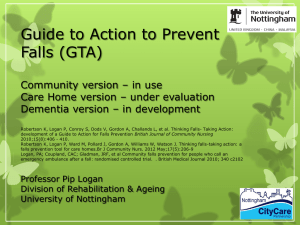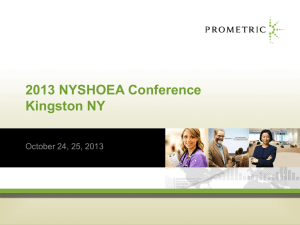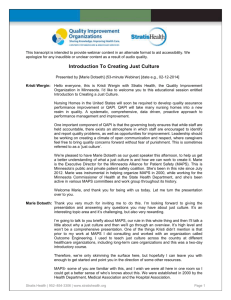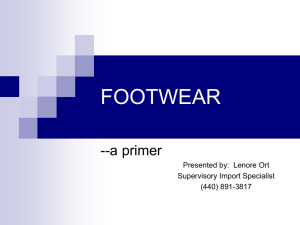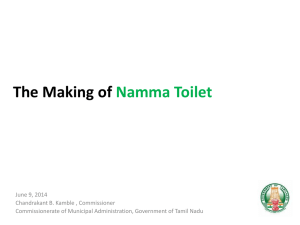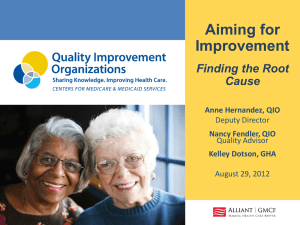Sue Ann Guildermann - Minnesota Department of Health
advertisement
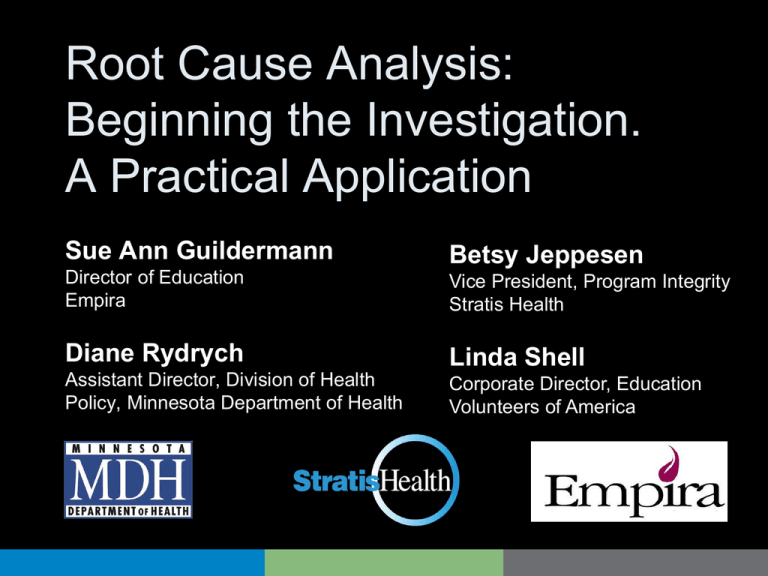
Root Cause Analysis: Beginning the Investigation. A Practical Application Sue Ann Guildermann Betsy Jeppesen Director of Education Empira Vice President, Program Integrity Stratis Health Diane Rydrych Linda Shell Assistant Director, Division of Health Policy, Minnesota Department of Health Corporate Director, Education Volunteers of America Background & benchmarking Empira: Consortium for 9 years, 28 SNFs / 5 companies Quality improvement task force applies for MN DHS Performance Incentive Payment Program (PIPP) ~ Empira members investigate greatest needs for improvement ~ Falls prevention – group identifies this as the area to work on Awarded a 3-year MN DHS PIPP grant beginning 10/1/08: ~ Measured QM/QI: 1.2 Falls 2.1 Depression & Anxiety 9.1 ADLs 9.3 Room movement ~ Reduce QM/QIs: 5% first year, 15% second year, 20% third year 16 SNFs, 4 companies in DHS PIPP Fall Prevention Root Cause Analysis: the corner stone of the Empira Fall Prevention Program RCA If you take the corner stone out, the entire structure falls down. RCA applied to fall prevention: • Why did the resident fall down? • Why might the resident fall down? Steps in Root Cause Analysis of a fall 1. Gather clues, evidence, and data, 10 Questions ~ physical environment ~ resident condition ~ system factors 2. Investigate and determine causal relationships, FSI Report, Fall Huddle, and Fall Team meeting: ~ Why did this happen? ~ What was different this time? ~ Are there system factors that contributed? 3. Implement corrective actions (interventions) to eliminate the root causes of the problem Gather clues, evidence, data • Observation skills are critical! – It’s easy to miss something you’re not looking for • Gather the clues – Look, listen, smell, touch – Note placement of resident and surrounding environment • Protect area around the incident: – Secure the room and equipment – Observation and recording begins immediately while things are fresh Awareness Test Three types of causes of falls (What are the clues and evidence you would observe for?) • Extrinsic – physical environmental, outside the body • Intrinsic – resident condition, inside the body • Systemic – operations, processes or procedures within the facility Extrinsic, intrinsic, systemic causes of falls • Extrinsic/External – Noise (e.g., alarms, TV) environmental contrasts, bed heights, room/bed assignment, placement of furniture and personal items, flooring, footwear/clothing, mats, lighting • Intrinsic/Internal – Resident activity at time of fall. B/P, O2 deprived. Balance, endurance, sleep deprivation, medications (type and amount) distance fall occurs from transfer surface, pain, continence status (toilet contents) cognitive status, mood, depression, vision/hearing loss • Systemic – Time of day, shift change, break times, day of week, location of fall, type of fall, footwear, staff assignments, staffing levels, policies and procedures Observing the scene 10 Questions for RCA of Falls: Directs observation process 1. 2. 3. 4. 5. Are you okay? What were you trying to do? What was different this time? Position (location, distance, position, etc.) Surrounding area (noise, visibility, furniture, clutter, toilet contents) 6. Floor (wet, urine, shiny, carpet, etc.) 7. Footwear 8. Assistive devices 9. Glasses/hearing aids 10. Who was in the area? Observing the scene Investigate physical environment Place of fall: At bedside, 5 feet away, > 15 feet Orthostatic, balance/gait, strength/endurance In bathroom/at commode: Urine or feces in toilet/commode? Urine on floor? contents of toilet Personal Items: Placement – easily seen? within reach? Availability – is it there? Cluttered – can’t find/can’t see it? Equipment Service Logs Completed? Who? When? What? Investigate physical environment • Noise: alarms*, TVs, talking – *Alarms as a diagnostic tool • Environmental contrasts – Toilet seat, thresholds, personal items, call light • • • • • • • Bed heights Room and bed assignment Placement of furniture and personal items Floor surfaces, mats Lighting Footwear and clothing Assistive devices Investigate resident condition 1. Orthostatic B/P, vital signs, PERRL, level of consciousness, bleeding, hand grasp 2. The 4Ps: pain, position, personal needs, personal items 3. Last meds? (Diuretic?) Med review needed? 4. Last eaten? Last voided? Sleep or rest deprived? 5. Labs: glucose level, Hgb and Hct (anemic), SO2, UA/UC, X-ray, Vit D level Root Cause Analysis Fall Occurs No Assessments and/or interventions Care Plan Employee and/or system failure Alterations from resident’s baseline Yes Alterations in Environment Why interventions sometimes don’t work Because they didn’t address the root causes of the fall. Observing the scene Questions? Sue Ann Guildermann Director of Education Empira 952-259-4477 sguilder@empira.org www.empira.org Betsy Jeppesen Vice President, Program Integrity Stratis Health 952-853-8510 or 877-787-2847 bjeppesen@stratishealth.org www.stratishealth.org Diane Rydrych Assistant Director Division of Health Policy Minnesota Department of Health 651-201-3564 Diane.rydrych@state.mn.us www.health.state.mn.us/patientsafety Linda Shell Corporate Director, Education and Learning Volunteers of America 651-503-8885 lshell@voa.org Protecting, maintaining and improving the health of all Minnesotans. Stratis Health is a nonprofit organization that leads collaboration and innovation in health care quality and safety, and serves as a trusted expert in facilitating improvement for people and communities.
